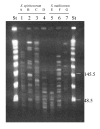Sphingobacterium respiratory tract infection in patients with cystic fibrosis
- PMID: 20030840
- PMCID: PMC2805677
- DOI: 10.1186/1756-0500-2-262
Sphingobacterium respiratory tract infection in patients with cystic fibrosis
Abstract
Background: Bacteria that belong to the genus Sphingobacterium are Gram-negative, non-fermentative bacilli, ubiquitous in nature and rarely involved in human infections. The aims of this study were to evaluate the epidemiology of infection by Sphingobacterium in a cohort of patients affected by Cystic Fibrosis (CF), the antibiotic susceptibility and the DNA fingerprinting of the isolated strains and to analyze some clinical outcomes of the infected patients.
Findings: Between January 2006 and June 2008, patients (n = 332) attending the Regional CF Unit in Naples, Italy, were enrolled. Sputum samples were processed for microscopic, cultural, phenotypic identification and antibiotic susceptibility testing. DNA fingerprinting was performed by pulsed-field gel electrophoresis (PFGE). A total of 21 strains of Sphingobacterium were isolated from 7 patients (13 of S. spiritovorum, 8 of S. multivorum). S. multivorum isolates were more resistant than those of S. spiritovorum. PFGE profiles were in general heterogeneous, which suggested independent circulation.
Conclusions: This is the first Italian report about respiratory tract infections by Sphingobacterium in CF patients. In our cohort, these infections were not associated with a deterioration of pulmonary function during the follow-up period. Although the exact role of this microorganism in CF lung disease is unknown and the number of infected patients was small, this study could represent an important starting-point for understanding the epidemiology and the possible pathogenic role of Sphingobacterium in CF patients.
Figures

Similar articles
-
Chryseobacterium respiratory tract infections in patients with cystic fibrosis.J Infect. 2007 Dec;55(6):518-23. doi: 10.1016/j.jinf.2007.08.002. Epub 2007 Sep 21. J Infect. 2007. PMID: 17889369
-
[Sphingobacterium multivorum infection in a child with an extensive burn].Rev Chilena Infectol. 2021 Jun;38(3):452-454. doi: 10.4067/S0716-10182021000300452. Rev Chilena Infectol. 2021. PMID: 34479305 Spanish.
-
Sphingobacterium multivorum cellulitis: case report and mini-review.New Microbes New Infect. 2024 Oct 10;62:101502. doi: 10.1016/j.nmni.2024.101502. eCollection 2024 Dec. New Microbes New Infect. 2024. PMID: 39483704 Free PMC article. Review.
-
Microbiology of airway disease in a cohort of patients with cystic fibrosis.BMC Infect Dis. 2006 Jan 11;6:4. doi: 10.1186/1471-2334-6-4. BMC Infect Dis. 2006. PMID: 16405721 Free PMC article.
-
Bacteriology and treatment of infections in the upper and lower airways in patients with primary ciliary dyskinesia: adressing the paranasal sinuses.Dan Med J. 2017 May;64(5):B5361. Dan Med J. 2017. PMID: 28552099 Review.
Cited by
-
Freshwater and Marine Environments in California Are a Reservoir of Carbapenem-Resistant Bacteria.Microorganisms. 2024 Apr 16;12(4):802. doi: 10.3390/microorganisms12040802. Microorganisms. 2024. PMID: 38674746 Free PMC article.
-
Sphingobacterium multivorum Bacteremia and Acute Meningitis in an Immunocompetent Adult Patient: A Case Report.Iran Red Crescent Med J. 2016 Aug 2;18(9):e38750. doi: 10.5812/ircmj.38750. eCollection 2016 Sep. Iran Red Crescent Med J. 2016. PMID: 28144466 Free PMC article.
-
Sphingobacterium spiritivorum septicaemia associated with cellulitis in a patient with Parkinson's disease.BMJ Case Rep. 2016 May 9;2016:bcr2016215319. doi: 10.1136/bcr-2016-215319. BMJ Case Rep. 2016. PMID: 27161206 Free PMC article.
-
Distribution of antibiotic-resistant bacteria in chicken manure and manure-fertilized vegetables.Environ Sci Pollut Res Int. 2014 Jan;21(2):1231-41. doi: 10.1007/s11356-013-1994-1. Epub 2013 Jul 27. Environ Sci Pollut Res Int. 2014. PMID: 23892601
-
Sphingobacterium multivorum: An Atypical Bacterium in an Atypical Place.Eur J Case Rep Intern Med. 2019 Sep 11;6(9):001214. doi: 10.12890/2019_001214. eCollection 2019. Eur J Case Rep Intern Med. 2019. PMID: 31583212 Free PMC article.
References
-
- Olivier K, Yankaskas JR, Knowles MR. Nontuberculous mycobacterial pulmonary diseases in cystic fibrosis. Semin Respir Infect. 1996;11:272–284. - PubMed
LinkOut - more resources
Full Text Sources

